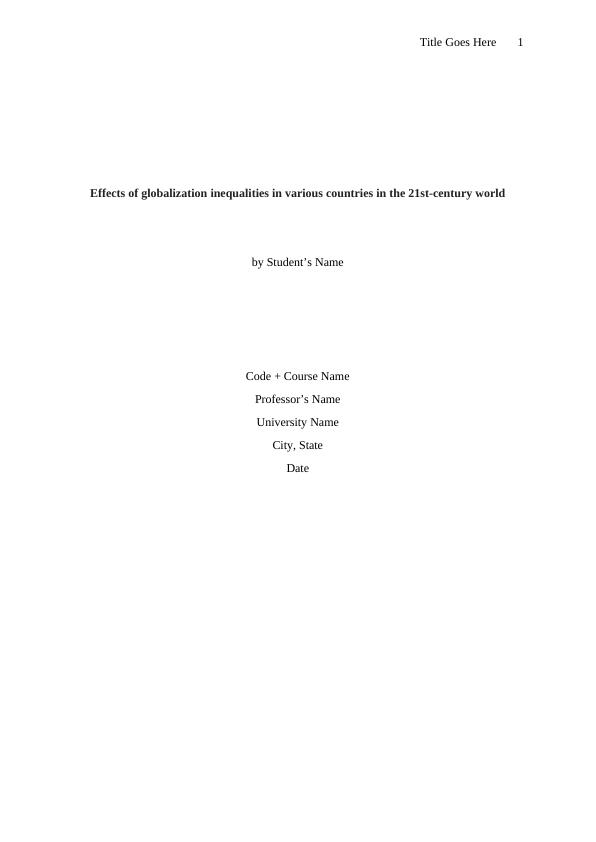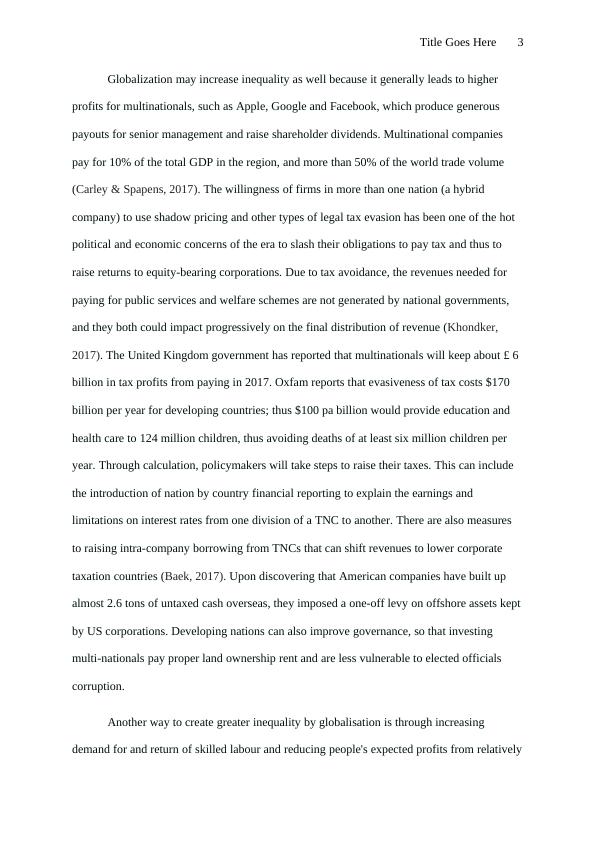Effects of globalization inequalities in various countries in the 21st-century world Literature Review 2022
9 Pages2427 Words14 Views
Added on 2022-08-29
Effects of globalization inequalities in various countries in the 21st-century world Literature Review 2022
Added on 2022-08-29
ShareRelated Documents
Title Goes Here 1
Effects of globalization inequalities in various countries in the 21st-century world
by Student’s Name
Code + Course Name
Professor’s Name
University Name
City, State
Date
Effects of globalization inequalities in various countries in the 21st-century world
by Student’s Name
Code + Course Name
Professor’s Name
University Name
City, State
Date

Title Goes Here 2
Global goods and services exchange, cross-border investment and labor movement
between nations is a mechanism for integrating and interdependent nations, businesses and
individuals. The disparity between income and resources can be calculated in different ways.
Gini and Palma Ratio are the main ones. Finally, the level of disparity is positive because it
measures wages flowing to 10% of families and splits the incomes by 40% below. This
percentage is 7.1 in South Africa, while the palma number for Germany is just above 3.
The effects of increasing specialization and trade can lead one way to globalisation.
The rise in export-to-GDP levels implies that exchange between countries and regions is
growing in amount and value. Trade based on comparative advantages can also increase
relative poverty, while it is potentially likely to boost economic growth and increase the per
capita income. In this sector, domestic stocks, employment and real incomes will be
decreased if a country is able to import cheaper steel from elsewhere. This can lead to higher
structural unemployment rates and a decrease in actual standards of living (Fioramonti,
2016). Real wages are exposed to downward pressure and can increase inequality. For
instance in the areas in the UK, where de-industrialisation has culminated in significantly
higher long-term unemployment rates and declining economic and social poverty. The
percentage of the national income that was received From 11% in 1980 to 20% of the US
population, in 2014, only 13% of the population in the whole lowest half of the population
increased to just 20%. One can also contend that the positives of globalisation. When trade
generates higher GDP growth, tax revenues that may be used to finance capital expenditures
in public goods and services, including financing for re-workout projects and infrastructure
improvement in economically depressed areas, would rise in the country (Horner & Hulme,
2019). Much depends on the government being able to enforce the successful national and
industrial policy with enough money and political will to boost the work prospective of
internationally adversely affected citizens.
Global goods and services exchange, cross-border investment and labor movement
between nations is a mechanism for integrating and interdependent nations, businesses and
individuals. The disparity between income and resources can be calculated in different ways.
Gini and Palma Ratio are the main ones. Finally, the level of disparity is positive because it
measures wages flowing to 10% of families and splits the incomes by 40% below. This
percentage is 7.1 in South Africa, while the palma number for Germany is just above 3.
The effects of increasing specialization and trade can lead one way to globalisation.
The rise in export-to-GDP levels implies that exchange between countries and regions is
growing in amount and value. Trade based on comparative advantages can also increase
relative poverty, while it is potentially likely to boost economic growth and increase the per
capita income. In this sector, domestic stocks, employment and real incomes will be
decreased if a country is able to import cheaper steel from elsewhere. This can lead to higher
structural unemployment rates and a decrease in actual standards of living (Fioramonti,
2016). Real wages are exposed to downward pressure and can increase inequality. For
instance in the areas in the UK, where de-industrialisation has culminated in significantly
higher long-term unemployment rates and declining economic and social poverty. The
percentage of the national income that was received From 11% in 1980 to 20% of the US
population, in 2014, only 13% of the population in the whole lowest half of the population
increased to just 20%. One can also contend that the positives of globalisation. When trade
generates higher GDP growth, tax revenues that may be used to finance capital expenditures
in public goods and services, including financing for re-workout projects and infrastructure
improvement in economically depressed areas, would rise in the country (Horner & Hulme,
2019). Much depends on the government being able to enforce the successful national and
industrial policy with enough money and political will to boost the work prospective of
internationally adversely affected citizens.

Title Goes Here 3
Globalization may increase inequality as well because it generally leads to higher
profits for multinationals, such as Apple, Google and Facebook, which produce generous
payouts for senior management and raise shareholder dividends. Multinational companies
pay for 10% of the total GDP in the region, and more than 50% of the world trade volume
(Carley & Spapens, 2017). The willingness of firms in more than one nation (a hybrid
company) to use shadow pricing and other types of legal tax evasion has been one of the hot
political and economic concerns of the era to slash their obligations to pay tax and thus to
raise returns to equity-bearing corporations. Due to tax avoidance, the revenues needed for
paying for public services and welfare schemes are not generated by national governments,
and they both could impact progressively on the final distribution of revenue (Khondker,
2017). The United Kingdom government has reported that multinationals will keep about £ 6
billion in tax profits from paying in 2017. Oxfam reports that evasiveness of tax costs $170
billion per year for developing countries; thus $100 pa billion would provide education and
health care to 124 million children, thus avoiding deaths of at least six million children per
year. Through calculation, policymakers will take steps to raise their taxes. This can include
the introduction of nation by country financial reporting to explain the earnings and
limitations on interest rates from one division of a TNC to another. There are also measures
to raising intra-company borrowing from TNCs that can shift revenues to lower corporate
taxation countries (Baek, 2017). Upon discovering that American companies have built up
almost 2.6 tons of untaxed cash overseas, they imposed a one-off levy on offshore assets kept
by US corporations. Developing nations can also improve governance, so that investing
multi-nationals pay proper land ownership rent and are less vulnerable to elected officials
corruption.
Another way to create greater inequality by globalisation is through increasing
demand for and return of skilled labour and reducing people's expected profits from relatively
Globalization may increase inequality as well because it generally leads to higher
profits for multinationals, such as Apple, Google and Facebook, which produce generous
payouts for senior management and raise shareholder dividends. Multinational companies
pay for 10% of the total GDP in the region, and more than 50% of the world trade volume
(Carley & Spapens, 2017). The willingness of firms in more than one nation (a hybrid
company) to use shadow pricing and other types of legal tax evasion has been one of the hot
political and economic concerns of the era to slash their obligations to pay tax and thus to
raise returns to equity-bearing corporations. Due to tax avoidance, the revenues needed for
paying for public services and welfare schemes are not generated by national governments,
and they both could impact progressively on the final distribution of revenue (Khondker,
2017). The United Kingdom government has reported that multinationals will keep about £ 6
billion in tax profits from paying in 2017. Oxfam reports that evasiveness of tax costs $170
billion per year for developing countries; thus $100 pa billion would provide education and
health care to 124 million children, thus avoiding deaths of at least six million children per
year. Through calculation, policymakers will take steps to raise their taxes. This can include
the introduction of nation by country financial reporting to explain the earnings and
limitations on interest rates from one division of a TNC to another. There are also measures
to raising intra-company borrowing from TNCs that can shift revenues to lower corporate
taxation countries (Baek, 2017). Upon discovering that American companies have built up
almost 2.6 tons of untaxed cash overseas, they imposed a one-off levy on offshore assets kept
by US corporations. Developing nations can also improve governance, so that investing
multi-nationals pay proper land ownership rent and are less vulnerable to elected officials
corruption.
Another way to create greater inequality by globalisation is through increasing
demand for and return of skilled labour and reducing people's expected profits from relatively

End of preview
Want to access all the pages? Upload your documents or become a member.
Related Documents
Essay on Strategies Of Economics Developmentlg...
|11
|3685
|547
Best Homework Help With Diskliblg...
|4
|417
|8
Comparing Political Systemslg...
|8
|1983
|37
Effects of Globalisation on World Trade, Income Distribution, Labour Standards, and Unemployment in Third World Countrieslg...
|10
|2522
|306
Economy of Singapore and Policy Debatelg...
|12
|3025
|37
Sample Assignment on International Tradelg...
|6
|736
|375
